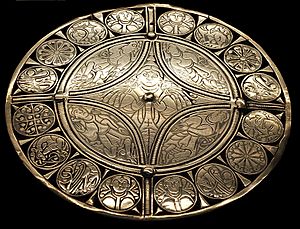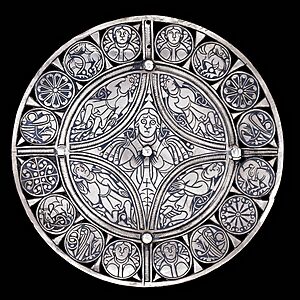Fuller Brooch facts for kids
Quick facts for kids Fuller Brooch |
|
|---|---|

Fuller Brooch as displayed in the British Museum
|
|
| Material | Silver and niello |
| Size | 11.4 cm in diameter |
| Created | Late 9th Century AD |
| Present location | British Museum, London |
| Registration | M&ME 1952,0404.1 |
The Fuller Brooch is a very special piece of Anglo-Saxon art. It's a brooch made of silver and a black material called niello. This amazing brooch was created in the late 800s AD. Today, you can see it at the British Museum in London, usually in Room 41. People think it's one of the most beautiful examples of Anglo-Saxon art because of its detailed pictures. These pictures show the Five Senses, and the black niello makes them stand out.
Contents
What is the Fuller Brooch?
The Fuller Brooch is a large, round disc. It was made from a thin sheet of hammered silver. The brooch is about 11.4 centimeters (or 4.5 inches) wide. Black niello is carefully placed into the engraved lines to create the designs.
The Five Senses in Art
The most interesting part of the brooch is its center. Here, you'll find pictures that show the five senses. In the very middle is Sight, shown with big, staring eyes. Around Sight, there are four other figures, each in its own small section.
- Taste is shown with a hand in his mouth.
- Smell has his hands behind his back and stands between two tall plants.
- Touch is rubbing his hands together.
- Hearing holds his hand to his ear.
This brooch is the earliest known artwork that shows all five human senses together.
Designs on the Edge
Around the main central picture, there's an outer border. This border has 16 small, round sections. Each of these sections is decorated with different designs. You can see human faces, birds, animals, and plant patterns.
How the Brooch Was Made
The style of the Fuller Brooch is called the "Trewhiddle style". This was a popular way of decorating metalwork in Anglo-Saxon England. It often used detailed animal patterns and plant designs.
Materials Used
The brooch is made of silver. The black parts are made of niello. Niello is a special mix of metal powders, usually silver, copper, and lead, that are heated until they melt. This melted mix is then poured into engraved lines on metal. When it cools, it becomes a hard, black substance. Scientists have studied the niello on the Fuller Brooch. They found it's mostly silver sulphide. This type of niello was common in the early medieval period. This discovery helps prove that the brooch is very old and not a modern copy. Another similar brooch, the Strickland Brooch, also in the British Museum, uses the same type of niello.
The Brooch's Journey Through Time
The Fuller Brooch is in excellent condition, which is quite rare for such an old item. The original pin that held it onto clothes is gone. Also, a small hole was made at the top, probably so it could be hung up like a pendant. It might be the only piece of everyday Anglo-Saxon metalwork that has never been buried since it was made!
Almost a Fake?
Because the brooch was in such perfect shape, some experts thought it might be a fake. Sir Charles Hercules Read, who was in charge of British and Medieval Antiquities at the British Museum, even thought it was a forgery. He told the Ashmolean Museum in Oxford, where the brooch was on loan, to take it off display.
How it Got its Name
After being taken off display, a man named Captain A. W. F. Fuller bought the brooch. He paid only the price of the silver it contained. In 1952, Captain Fuller gave the brooch to the British Museum. He had one condition: that the brooch would always be called the "Fuller Brooch" in his honor. And that's how this amazing piece of history got its name!


